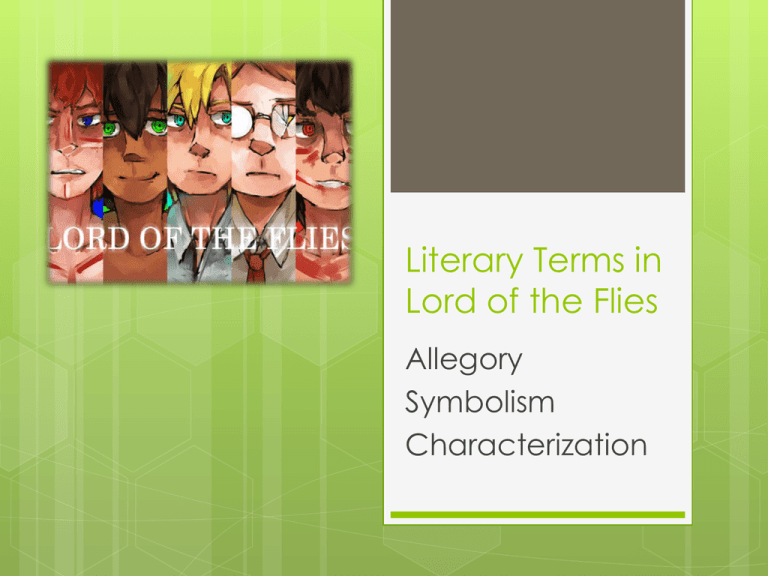Imagine a group of British schoolboys stranded on a deserted island, free from the constraints of civilization. What would happen? Would they maintain order and civility, or would the absence of adults unleash primal instincts, leading to chaos and savagery? This is the core question investigated in William Golding’s haunting novel, “Lord of the Flies.” Beyond a compelling narrative, “Lord of the Flies” is a masterpiece of literary technique, utilizing a diverse array of literary devices to meticulously craft its chilling exploration of human nature.

Image: www.blendspace.com
This article delves into the rich tapestry of literary terms woven into the fabric of “Lord of the Flies.” We’ll explore various techniques, from symbolism and allegory to foreshadowing and irony, that not only enhance the narrative but also contribute to the novel’s enduring impact and relevance. Understanding these devices will unlock profound insights into the novel’s thematic complexities and provide a deeper appreciation for its enduring power.
Symbolism: A World of Meanings
Symbolism acts as the silent language of “Lord of the Flies,” where objects and characters carry profound meaning beyond their literal forms. The most recognizable symbol is the **Lord of the Flies** itself, the rotting pig’s head worshipped by the boys. This symbol embodies the savagery lurking within humanity, the allure of primal instinct, and the fearsome consequences of unchecked power.
The **island** itself serves as a symbol of isolation and a microcosm of the world. It represents a world stripped bare of civilization, where humanity is exposed in its purest, most primal form. The **fire** symbolizes hope, communication, and the potential for rescue. However, it also signifies the destructive power of uncontrolled forces and the boys’ inability to harness their potential.
Allegory: An Extended Metaphor
The novel functions on a deeper allegorical level, drawing parallels between the boys’ story and larger universal truths. The boys’ descent into savagery mirrors the downfall of humanity itself, a cautionary tale about the fragility of civilization and the ever-present threat of barbarity. The **island** can be interpreted as a representation of the world, while the **boys** represent humankind in its entirety.
The novel also provides a potent allegory for the **human condition**. The conflict between civilization and savagery that plays out on the island echoes the internal struggles we all face in our lives. The boys’ yearning for order and their susceptibility to primal urges highlight the human capacity for both good and evil.
Foreshadowing: Whispers of the Future
Golding masterfully employs foreshadowing to create an atmosphere of impending doom and build suspense. Early in the novel, **Ralph dreams of a beast**, a vision that foreshadows the escalating chaos and the emergence of a tangible manifestation of their collective fear. The **boys’ fascination with the island’s dark and mysterious side** hints at the danger that awaits them. The **repeated emphasis on the island’s isolation** foreshadows the boys’ eventual descent into self-destruction.

Image: studylib.net
Irony: A Twist of Fate
Irony permeates the narrative, creating a constant sense of unease and highlighting the tragic irony of the boys’ situation. The **boys are rescued by a naval officer**, an ironic twist considering the boys’ utter destruction of the island and their own savagery. The **officer’s ignorance of the events that transpired**, and his assumption of the boys’ innocence, underscores the tragic irony of their predicament.
The **boys’ attempts to build a civilization**, ultimately failing, represents a broader irony in how civilization itself is fragile and susceptible to forces that seek to destroy it. This is further emphasized by the novel’s ending, where **the boys are rescued by a world that is itself teetering on the brink of destruction.**
Character Development: From Innocence to Savagery
Each boy in the novel undergoes a distinct transformation, reflecting the novel’s central theme. **Ralph**, the elected leader, embodies reason, order, and the desire for civilization. However, his power gradually diminishes as the boys succumb to savagery. **Jack**, on the other hand, embodies primal urges and the allure of power. He rises to prominence by appealing to the boys’ baser instincts and leads them into a descent into violence.
The characters of **Simon** and **Piggy** serve as tragic foils to Jack. Simon represents spirituality and enlightenment, attempting to connect with the island’s mystical side. Piggy embodies intellect and reason, attempting to maintain order and civilization. However, both characters are brutally extinguished, representing the demise of reason and spirituality in the face of unchecked savagery.
Themes: A Universal Exploration
Through these literary techniques, Golding explores timeless themes with profound impact. The novel delves into the nature of **human savagery and the potential for good and evil** that resides within every individual. It examines the **importance of order and civilization**, contrasting the fragility of social structures with the allure of primal instinct.
“Lord of the Flies” also explores the power of **fear** and the **influence of societal norms** on an individual’s behavior. The boys’ descent into savagery is fueled by fear, both of the unknown and of each other. The absence of authority and the lack of societal norms provide a breeding ground for chaos and violence.
Lord Of The Flies Literary Terms
A Lasting Legacy
Using a masterful blend of literary techniques, “Lord of the Flies” transcends time and continues to be relevant today. Its exploration of human nature, its chilling portrayal of the darkness within us, and its potent warnings about the fragility of civilization resonate deeply with audiences of all ages.
Whether you’re a student analyzing the text for a literature class or a reader seeking deeper understanding, exploring the literary terms embedded in “Lord of the Flies” is a rewarding endeavor. By deciphering the layers of meaning, the symbolism, and the allegorical interpretations, you can unlock the full potential of this enduring masterpiece and gain a deeper understanding of the complex and often contradictory nature of humanity.





